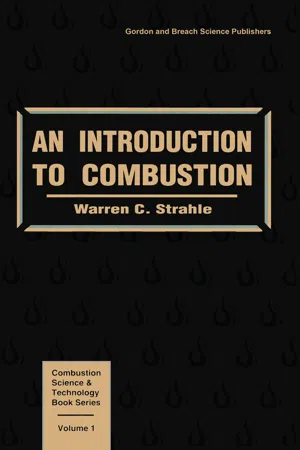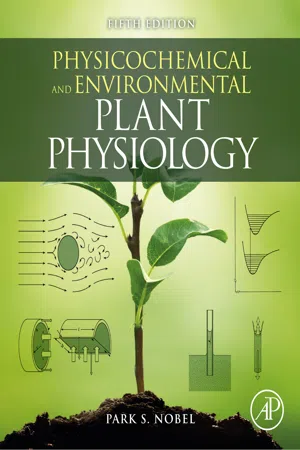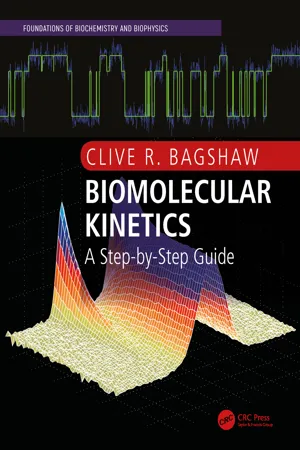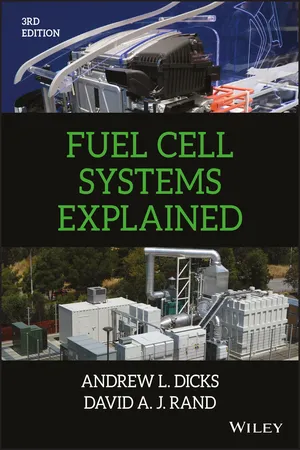Free Energy of Formation
The free energy of formation is a measure of the stability of a compound relative to its elements in their standard states. It represents the change in free energy when a compound is formed from its constituent elements. A negative value indicates that the compound is more stable than its elements, while a positive value indicates the opposite.
8 Key excerpts on "Free Energy of Formation"
- eBook - ePub
- Jeffrey Gaffney, Nancy Marley(Authors)
- 2017(Publication Date)
- Elsevier(Publisher)
...The standard state of an element or a compound is defined as the most stable form of the physical state that exists at 1 atmosphere pressure and 298 K. For the chemical reaction that results in the formation of a molecule directly from its elements, the standard enthalpy is called the standard enthalpy of formation or standard heat of formation (Δ H ° f). Other types of standard enthalpies include the standard enthalpy of neutralization (Δ H ° neut), which is the change in enthalpy that occurs when an acid and a base undergo a neutralization reaction to form one mole of water and a salt, and standard enthalpy of combustion (Δ H ° comb), which is the enthalpy change that occurs when one mole of the compound is burned completely in oxygen. Here we will focus mainly on the standard enthalpies of formation. Standard enthalpies of formation are very useful in determining whether a compound is stable at the standard room temperature of 298 K. They are also useful in determining the enthalpies of formation for unknown reactions or reactions that are not easy to measure quantitatively. The standard enthalpy of formation is defined as the change in enthalpy that occurs during the formation of one mole of a compound from its elements, with all substances in their standard states. So, the chemical equation describing the formation must be written with all species in their standard states and the stoichiometry of the reaction must be set so that that one mole of product is produced. For example, the reaction of solid carbon with oxygen to form carbon monoxide is normally written as; 2C s + O 2 g → 2CO g However, the stoichiometry of this equation shows two moles of carbon monoxide being produced...
- eBook - ePub
- Warren C. Strahle, William A. Sirignano, William A. Sirignano(Authors)
- 2020(Publication Date)
- Routledge(Publisher)
...In the above hydrogen—fluorine example the substances, in fact, behave as ideal gases so that we may write at the 1 bar, 298 K condition The Q P comes out as a difference between the enthalpies of the product and the elements from which it is formed. In principle, all compounds can be formed by reactions by their constituent elements. In thermodynamics we never know absolute values of energy variables, but that is not important because only changes in these variables are dealt with in thermodynamics. To facilitate numerical work, we define a reference set of substances and their thermodynamic properties. We define reference chemicals as the elements in the form most abundantly found in nature when they are found alone. So, for example, oxygen in the air is found as the diatomic molecule O 2 in the gas phase. The reference state for oxygen is the gaseous diatomic molecule. Similarly, reference states for fluorine, hydrogen, and nitrogen are gaseous F 2, H 2, and N 2 respectively, not F, H, and N. By contrast, the reference state for carbon is C(s), or graphite. We define formation reactions for a compound or atom as the reaction that forms one mole of the substance from the elements or element in their reference state. The heat of formation for a substance is the standard state enthalpy change for a reaction forming the substance from its reference state elements. Moreover, for thermodynamic reference the heat of formation of the elements in their standard states is defined as zero. The heat of formation may be defined at any temperature and for species i. It is denoted as In the above hydrogen—fluorine reaction it is clear that it was a formation reaction at 298 K, since hydrogen and fluorine behave perfectly at the stated conditions...
- Kevin Reel, Derrick C. Wood, Scott A. Best(Authors)
- 2014(Publication Date)
- Research & Education Association(Publisher)
...Free energy is the energy available to do work, and takes the enthalpy and entropy of a reaction into account. If ΔG is negative, the reaction will be spontaneous; positive ΔG values mean that the reaction is nonspontaneous; and when ΔG = 0, the system is at equilibrium—meaning there is no preference. The Gibbs free energy value is related to the enthalpy and entropy according to the Gibbs-Helmholtz equation: Alternatively, the Gibbs free energy value can be calculated from Free Energy of Formation values (ΔG f °) acquired under standard conditions through the summation equation: EXAMPLE: Using the following values, determine whether or not the burning of sugar (C 12 H 22 O 11) will be a spontaneous process. SOLUTION: Because the units are not matching up, the ΔS° should be converted to kJ/mol. The Gibbs free energy is calculated using the Gibbs-Helmholtz equation, using the temperature of 298 K because the data is for standard conditions. Because the ΔG° is negative, this reaction is spontaneous. TEST TIP Make sure the units are matching up when plugging into the Gibbs equation, which will likely require you to convert the temperature into Kelvin and the ΔS° in kJ/mol K. Predicting Reaction Spontaneity On the AP Chemistry exam, you may be asked to predict the spontaneity of a reaction based solely on qualitative determinations. You should familiarize yourself with Table 10.1, which describes the possible scenarios for enthalpy, entropy, and free energy based on the signs of ΔH, ΔS, and ΔG and the equation: Δ G = Δ H – T Δ S Table 10.1. Reaction Spontaneity: Possible Scenarios for Enthalpy, Entropy, and Free Energy Table 10.2. Thermo Signs and Symbols Summary Sign and Symbol Meaning –ΔH Exothermic; heat given off +ΔH Endothermic; heat absorbed –ΔS Decrease entropy; more organized +ΔS Increase entropy; more random/disordered –ΔG Spontaneous +ΔG Nonspontaneous...
- Park S. Nobel(Author)
- 2020(Publication Date)
- Academic Press(Publisher)
...The chemical potential is actually the partial molal Gibbs free energy with respect to that species; that is, μ j equals (∂ G / ∂ n j) T, P, E, h, n i (Eq. IV.9 in Appendix IV), where the subscripts on the partial derivative indicate the variables that are held constant. We must consider the Gibbs free energy of an entire system to determine the chemical potential of species j. In turn, G depends on each of the species present, an appropriate expression being G = ∑ j n j μ j (6.1) where n j is the number of moles of species j in some system, μ j is the chemical potential of species j (Eq. 2.4), and the summation is over all of the species present (Eq. 6.1 is derived in Appendix IV). The Gibbs free energy is expressed relative to some arbitrary zero level—the arbitrariness in the baseline for G in Equation 6.1 is a consequence of the μ j ∗ included in each μ j (Fig. 6-1). The Gibbs free energy as represented by Equation 6.1 is very useful for applying free energy concepts to bioenergetics. 6.1A. Chemical Reactions and Equilibrium Constants From the thermodynamic point of view, we are interested in the overall change in free energy for an individual reaction—or perhaps a sequence of reactions. Let us consider a general chemical reaction for which A and B are the reactants and C and D are the products: a A + b B ⇌ c C + d D (6.2) where a, b, c, and d are the numbers of moles of the various species taking part in the reaction. The steps to develop a useful expression for the change in Gibbs free energy for this chemical reaction are as follows: Step Eq...
- eBook - ePub
- Kevin R. Reel(Author)
- 2013(Publication Date)
- Research & Education Association(Publisher)
...exist under standard conditions. • The free energy is the maximum amount of heat that can be devoted to performing work by a reaction. Example: Use the following table of free energies to calculate the free energy for the combustion of one mole of ethanol. 2 C 2 H 5 OH (l) + 6O 2 (g) →4CO 2 (g) + 6H 2 O (g) Species (kJ/mol) C 2 h 5 oh (l) ΔG f = −175 O 2 (g) ΔG f = 0 Co 2 (g) ΔG f = −394 H 2 O (g) ΔG f = −229 Solution: ΔG° reaction = (products). − (reactants) ΔG° reaction = [(4 ×−394) + (6 ×−229)] − (− 175) ΔG° reaction = −2775 kJ Hess ’ s Law and Free Energies • Hess’s law works with free energies as well as enthalpies. • The ΔG° of a reaction that is composed of multiple steps is equal to the sum of the ΔG° from each step. ΔG°, K, AND E° Example: Given the following thermodynamic data, calculate ΔG°, equilibrium constant, and E° total for the reaction that turns iron metal into rust (Fe 2 O 2 (s)) under standard conditions. Species (kJ) S ° (J/ K mol) Fe 2 O 3 (s) −826 90 O 2 (g) 0 205 Fe (s) 0 28 Solutions: (i) Find Δ H ° for the reaction, 2Fe(s) + 3/2 O 2 (g). →Fe 2 O 3 (s) ΔH° reaction = ∑H° f (products) −∑H° f (reactants) = −826 kJ (ii) Find Δ S ° for the reaction, 2Fe(s) +3/2 O 2 (g) →Fe 2 O 3 (s) ΔS° = ∑S° (products) −∑S° (reactants) ΔS° = (90) −[(1.5 ×205) + (2 ×27)] = −271.5 = −272 J/K mol (iii) Find Δ G ° for the reaction, 2Fe(s) + 3/2 O 2 (g) →Fe 2 O 3 (s) ΔG° = ΔH° − TΔS° = −826 −(298)(−0.272) = −745 kJ (iv) Find E ° total from Δ G ° ΔG° = −nFE° total E ° total = = 745,000 J / (3)(98,486 C) = 2.52 V (v) Find K. from Δ G ° ΔG° = −RT ln K ln K = −ΔG°/RT = 300 K = e −ΔG°/RT = e 300 (a very large number!)...
- eBook - ePub
Biomolecular Thermodynamics
From Theory to Application
- Douglas Barrick(Author)
- 2017(Publication Date)
- CRC Press(Publisher)
...These partial molar quantities are intensive analogs of quantities such as energy, volume, and heat capacity, and provide a fundamental expression chemical reactivity. Of particular importance is the partial molar Gibbs free energy, referred to as the “chemical potential.” In Chapter 4, we developed entropy as a thermodynamic potential to describe the direction of spontaneous change. The entropy acts as a thermodynamic potential as long as a system is isolated, that is, when there is no work, no heat flow, and no material exchange between system and the surroundings. While this is a useful way to think about the thermodynamics of the universe (where, by definition, there is no surroundings with which to interact), systems studied in the laboratory are not isolated from their surroundings (Figure 5.1A). Figure 5.1 Laboratory and biological systems at constant pressure and temperature. (A) A typical laboratory sample containing a solution of large and small molecules in various states of conformation, assembly, and reaction. The sample is open to atmospheric pressure, so it can expand and contract while maintaining constant p, and has a resistive heater and/or heat sink that can maintain constant sample temperature. The distribution of various molecular species can be measured using devices such as light sources and detectors. (B) Living biological systems. Left, a bacterial cell; middle, eukaryotic cells in a culture dish; right, animals and a plant. In all three cases, temperature and pressure are usually constant (or vary slowly compared to processes of interest). In addition, material (and in one case, light) is exchanged among these living systems and their surroundings. Typically, laboratory systems are held at constant temperature and pressure (partly because such conditions are easy to achieve, requiring no thermal or mechanical insulation), which allows heat to flow and work to be done as a result of from volume change...
- eBook - ePub
Biomolecular Kinetics
A Step-by-Step Guide
- Clive R. Bagshaw(Author)
- 2017(Publication Date)
- CRC Press(Publisher)
...This is analogous to tossing a coin and getting n heads in a row. If an active energy source modulated the compression spring constant, then net rotation could be derived from the random motions of the polymer. Such biased random motions of polymer chains play a key role in molecular motors (Section 5.4). For further discussion of ratchets in biology, see Hoffmann [ 70 ]. Note that the classical Laws of Thermodynamics were derived through the accumulation of many observations rather than any underlying physical principle. The central ideas were established long before the focus on molecular species, but the principles were subsequently examined through statistical thermodynamics. Here, the average behavior of a system made up of an ensemble of particles is considered through the distributions of states based on their underlying probabilities. Although classical and statistical thermodynamics address the properties of ensembles of molecules, the principles apply to the behavior of a single molecule over a sufficiently long time period. 3.2 The Significance of Free Energy, ΔG A spontaneous reaction requires no external energy input for it to occur; it is a downhill process. Enthalpy changes (Δ H) alone cannot predict whether a chemical reaction will be spontaneous. While many spontaneous reactions are exothermic (Δ H < 0), this is not always so, indicating that another factor is at play. This factor is the change in entropy (ΔS). The concept of the free energy change, Δ G, as a criterion of spontaneity was therefore introduced to account for entropy changes: Δ G = Δ H − T Δ S 3.4 3.4 where T is the absolute temperature. A spontaneous reaction is associated with a Δ G < 0. The change in entropy relates to the relative number of states the reactants and products can occupy. For example, for a spontaneous protein folding reaction, the Δ H term must be ≪ 0 in order to compensate for the loss in entropy, which on its own would give a positive Δ G...
- eBook - ePub
- Andrew L. Dicks, David A. J. Rand(Authors)
- 2018(Publication Date)
- Wiley(Publisher)
...Appendix 1 Calculations of the Change in Molar Gibbs Free Energy A1.1 Hydrogen Fuel Cell This appendix shows how to calculate the change in molar Gibbs free energy for the reaction: (A1.1) The Gibbs free energy (G) of a system (also known as Gibbs energy or Gibbs function) is defined in terms of the enthalpy (H), temperature (T) and entropy (S) according to the relationship: (A1.2) Similarly, the molar Gibbs Free Energy of Formation (), the molar enthalpy of formation () and the molar entropy () 1 are connected by the equation: (A1.3) In the case of the hydrogen oxidation reaction (A1.1), it is the change in energy that is important, i.e., the difference in energy between the reactants (hydrogen and oxygen) and the product (water or steam). Also, in a fuel cell, the temperature can be taken as constant 2 and, therefore, the following holds: (A1.4) The value of is the difference between of the products and of the reactants. Thus, for the hydrogen oxidation reaction: (A1.5) Similarly, Δ is the difference between of the products and of the reactants. Consequently, for the reaction under consideration: (A1.6) The values of and vary with temperature according to equations (A1.7) and (A1.8) given in the following text. These standard equations are derived using thermodynamic theory, and their proof can be found in textbooks on engineering thermodynamics. 3 The subscript to and is the temperature, and is the molar heat capacity at constant pressure. Standard temperature is taken as 298.15 K. The molar enthalpy of formation at temperature T is given by (A1.7) The molar entropy is given by: (A1.8) The values for both the molar enthalpy of formation and the molar entropy of formation at 298.15 K are obtainable from thermodynamics tables...







